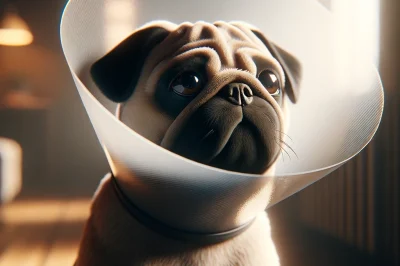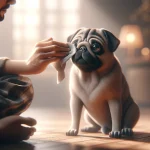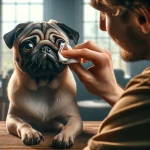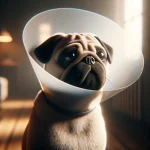Table of Contents

Key Takeaways
- Soft e-collars offer comfort and flexibility for your pug’s post-surgery recovery.
- Traditional e-collars are a tried-and-true option, known for their durability and effectiveness.
- Measuring your pug accurately is crucial for finding the best fitting e-collar.
- Each type of e-collar has its own set of advantages that can cater to your pug’s specific needs.
- Post-surgery care involves more than just selecting the right e-collar—it’s about creating a nurturing environment for your pug’s healing.
Ensuring Your Pug’s Comfort: Post-Surgery E-Collar Options
After surgery, the last thing you want is for your pug to feel more discomfort. That’s why choosing the right e-collar is so critical. There’s a variety of options out there, from soft e-collars to the traditional plastic cones. We’ll explore these options, focusing on your pug’s comfort and safety, so you can make an informed decision.
Deciding Between Soft and Traditional E-Collars
The e-collar, or Elizabethan collar, is a must-have to prevent your pug from interfering with their healing process. The traditional plastic cone has been the standard for years, but soft e-collars are gaining popularity for their comfort and flexibility. Your choice will depend on your pug’s temperament, the location of their wound, and their overall post-surgery needs.
Top Considerations for Your Pug’s Comfort
When it comes to your pug’s post-surgery attire, comfort is key. Here are some factors to keep in mind:
- Material: Soft e-collars are made from pliable fabrics, which can be more comfortable for resting and moving around.
- Size: A properly sized e-collar should extend beyond your pug’s nose to be effective, but not so long as to impede their movement.
- Durability: While soft e-collars are comfortable, make sure they’re sturdy enough to withstand your pug’s attempts to reach their wound.
Soft E-Collars: A Gentle Approach
Soft e-collars are like the cozy sweaters of the e-collar world. They’re made of flexible materials that allow for a snug fit, ensuring your pug can still go about their daily activities with ease. These collars are less intimidating for your pug and can help reduce stress during their recovery period.
Let’s dive into why a soft e-collar might be the best choice for your furry friend:
Advantages of Soft E-Collars
Soft e-collars come with several benefits, including being more comfortable for your pet and potentially less stressful. For more information, you can read about the best dog cones to understand why they might be a better choice over traditional collars.
- Comfort: They’re typically more comfortable than plastic cones, making it easier for your pug to sleep and relax.
- Visibility: Soft collars don’t obstruct your pug’s peripheral vision, helping them navigate their environment better.
- Flexibility: These collars can bend and flex, allowing your pug to move more naturally.
However, it’s important to note that soft e-collars may not be suitable for pugs who are determined to reach their wounds, as they can sometimes be easier to bypass than rigid cones. For more information on pug health and safety, consider reading about pug eye health and conditions.
Types of Soft E-Collars
Soft e-collars come in various shapes and designs. Some are like plush doughnuts that wrap around your pug’s neck, while others resemble the traditional cone but are made from softer materials. You’ll want to consider your pug’s size and the location of their surgery when selecting the style.
Measuring Your Pug for a Soft E-Collar
Getting the right fit is essential. Here’s how to measure your pug for a soft e-collar:
- Measure the length from the base of their neck to the tip of their nose. Add a couple of inches to ensure the collar extends beyond their snout.
- Measure the circumference of their neck to ensure the collar fits snugly without being too tight.
- Check the manufacturer’s sizing chart, as sizes can vary between brands.
Remember, a well-fitting e-collar is one that your pug can’t easily slip off, but still allows them to eat, drink, and rest without obstruction.
Example: Max, a delightful pug, needed an e-collar after a minor surgery. His owner chose a soft, adjustable collar that fit snugly around his neck without causing discomfort. Max could still enjoy his treats and naps, and his recovery was stress-free.
When to Opt for a Traditional E-Collar
Despite the comfort of soft e-collars, there are times when a traditional plastic cone is the best option for your pug. These situations usually involve pugs with high determination to reach their wounds or when the wound location is easily accessible, even with a soft collar. Traditional e-collars are more rigid, making it harder for these little escape artists to bend or maneuver around them.
Another scenario to consider a traditional e-collar is if your pug has a history of destroying softer materials. The sturdy plastic can withstand more wear and tear, ensuring that the protective barrier remains intact throughout the healing process.
Tips for Acclimating Your Pug to a Traditional Collar
Introducing your pug to a traditional e-collar can be challenging, but with patience and positive reinforcement, you can help them adjust. Start by allowing your pug to sniff and explore the collar. Associate it with treats and praise to create a positive connection. When you first put the collar on, keep it short and sweet, gradually increasing the time they wear it.
| Features | Soft E-Collars | Traditional E-Collars |
|---|---|---|
| Material | Made from pliable fabrics, offering comfort for resting and moving around | Typically made of rigid plastic, known for durability and effectiveness |
| Comfort | More comfortable than traditional collars, allowing for easier sleep and relaxation | Can be less comfortable due to their rigid nature, may cause more stress during recovery |
| Size | Properly sized to extend beyond the pug’s nose for effectiveness without impeding movement | Should be fitted accurately to prevent interference with wound healing while allowing normal activities |
| Durability | Sturdy enough to withstand pug’s attempts to reach wounds, ensuring long-lasting use. | Known for their durability and ability to resist wear and tear, providing effective protection. |
| Visibility | Does not obstruct peripheral vision, aiding in better navigation for the pug. | May obstruct peripheral vision, potentially hindering the pug’s ability to move around freely. |
| Flexibility | Can bend and flex, allowing natural movement for the pug during recovery. | Rigid structure may limit movement and comfort, especially in active pugs. |
| Advantages | – More comfortable for pets, potentially less stressful. – Better visibility and flexibility. – Lightweight and less intimidating for the pug. – Suitable for resting and daily activities with ease. | – Known for durability and effectiveness. – Provides a higher level of protection. – Ideal for preventing determined pugs from reaching wounds. – Can be crucial in cases where pugs have a history of destroying softer materials. |
Comparing E-Collar Comfort Levels
When weighing the options, comfort is a huge consideration. Soft e-collars are generally more comfortable for resting and less intimidating for your pug. They’re also lighter, which can be easier on your pug’s neck. However, traditional e-collars offer unmatched durability and a higher level of protection, which can be crucial for a successful recovery.
It’s about finding a balance between your pug’s comfort and the necessity to protect their wound. Sometimes, starting with a soft e-collar and switching to a traditional one if your pug tries to tamper with it can be a practical approach.
Assessing Your Pug’s Comfort
Observing your pug’s behavior is key to assessing their comfort level with an e-collar. A comfortable pug will be able to sleep, eat, and drink with minimal fuss. If your pug seems distressed, is having trouble navigating, or is persistently trying to remove the collar, it may be time to reassess your choice.
Keep an eye out for any signs of irritation or chafing around the neck area, as this could indicate that the collar is too tight or the material is not suitable for your pug’s sensitive skin.
Feedback from Pug Owners
Many pug owners have found that soft e-collars can be a game-changer for their pets’ comfort. These collars tend to be less cumbersome, allowing pugs to move more freely. Owners also appreciate the reduced noise that comes with soft collars—no more bumping into furniture or walls.
However, some owners stand by traditional e-collars for their foolproof nature. They share stories of pugs who have recovered smoothly without any complications because the rigid cone effectively prevented any access to the wound.
Ultimately, the feedback highlights the importance of knowing your pug’s personality and healing needs. What works for one pug might not work for another, and sometimes it’s a trial-and-error process to find the perfect fit.
Post-Surgery Recovery Tips
Post-surgery care for your pug extends beyond selecting the right e-collar. It’s about ensuring they have a calm and comfortable environment to recuperate in. Keep their bedding clean and cozy, and place their food and water bowls within easy reach.
Stick to your veterinarian’s instructions regarding wound care and medication. Keep activities low-key to prevent any unnecessary strain on their healing body, and always supervise your pug when they’re wearing an e-collar to ensure they’re coping well.
Creating a Healing Environment at Home
Your home should be a sanctuary for healing after your pug’s surgery. Limit access to stairs or slippery floors to prevent falls, and remove any obstacles that could cause your pug to trip or bump into while wearing their e-collar.
Soft lighting and a quiet space can help reduce stress, making your pug feel more secure as they recover. Additionally, ensure that their favorite toys are within reach for comfort, but avoid anything that might encourage rough play.
Monitoring for Complications
While your pug is on the mend, it’s crucial to monitor them for any signs of complications. Check the incision site regularly for redness, swelling, or discharge. If you notice any of these signs, or if your pug seems excessively lethargic or uninterested in food, contact your vet immediately.
Remember, your vigilance is a key component of your pug’s recovery. Quick action at the first sign of trouble can prevent minor issues from becoming major setbacks.
Keeping Your Pug Happy and Healthy Post-Surgery
Post-surgery isn’t just about physical healing; it’s also about keeping your pug’s spirits up. Continue to engage with them through gentle petting, kind words, and their favorite treats (as allowed by your vet). A happy pug is more likely to have a smooth recovery.
The Role of Nutrition in Recovery
Good nutrition plays a vital role in your pug’s recovery. Offer them a balanced diet that’s easy to digest and rich in nutrients to support healing. If your pug is reluctant to eat, try warming their food or hand-feeding them to encourage intake.
Always follow your vet’s dietary recommendations, especially if your pug is on medication that could affect their appetite or digestion. The right food can make all the difference in their energy levels and overall well-being during this critical time.
Managing Your Pug’s Activity Level
After surgery, it’s natural for your pug to want to spring back into their usual routine, but it’s crucial to manage their activity level to avoid any mishaps. Light walks are generally fine, but keep your pug on a short leash to prevent any sudden movements that could harm their recovery. It’s also wise to avoid playtime with other pets or children that could get too rough. The goal is to keep your pug relaxed and calm until they’re fully healed.
Remember, every pug is different, and your vet will give you the best advice on how to manage your pug’s recovery. Follow their guidelines closely, and if in doubt, err on the side of caution to keep your pug safe and sound.
Frequently Asked Questions (FAQ)
As a pug owner, you might have a lot of questions about e-collars and post-surgery care. Let’s address some common concerns to help you navigate this recovery period with confidence.
How Can I Tell if My Pug is Uncomfortable with Their E-Collar?
It’s important to monitor your pug’s behavior with their e-collar. Signs of discomfort can include scratching at the collar, whining, or difficulty eating and drinking. If the collar is too tight or causing chafing, you might also notice redness or irritation around their neck. In these cases, consult your vet for advice on adjustments or alternative solutions.
How Long Should My Pug Wear the E-Collar?
Your vet will provide specific instructions on how long your pug should wear the e-collar, which typically depends on the type of surgery and how quickly the wound is healing. It’s crucial to keep the e-collar on as long as recommended to prevent your pug from interfering with the healing process.
Can My Pug Eat and Drink Normally with an E-Collar?
Most pugs can eat and drink with an e-collar, but you may need to elevate their bowls or use shallower dishes to make it easier. Keep an eye on your pug during meal times to ensure they’re getting enough food and water, and make adjustments as needed for their comfort.
Are There Alternatives to E-Collars for Pugs?
Yes, there are alternatives like recovery suits, inflatable collars, or soft e-collars that might be more comfortable for your pug. These alternatives can work well for some pugs, but it’s essential to choose one that still effectively prevents them from reaching their wound.
How Can I Prevent My Pug from Tampering with the E-Collar?
To prevent your pug from tampering with their e-collar, make sure it’s fitted properly and securely. Distract your pug with toys or treats to shift their focus away from the collar. Consistently reinforcing positive behavior when they leave the collar alone can also help. If your pug continues to tamper with the e-collar, consult your vet for alternative solutions or adjustments.
Remember, the road to recovery for your pug may have its challenges, but with the right care, attention, and a suitable e-collar, your furry friend will be back to their playful self in no time. Your patience and dedication during this time are invaluable, and the wag of a tail and a loving snuggle will be your pug’s way of saying ‘thank you’ for all your care.
After your pug undergoes surgery, it’s crucial to ensure they are comfortable during the recovery process. A soft e-collar can be a great alternative to traditional, more rigid collars. These softer collars are designed to prevent your pug from licking or biting at their wounds while offering a more comfortable resting experience. For more detailed information on how to care for your pug’s post-surgery needs, consider exploring this comprehensive guide on pug eye health and conditions, which can be particularly useful if the surgery was eye-related.
- Best Pug Tear Stain Removers: Safe & Effective Solutions – 15 March 2024
- Pug Cherry Eye Surgery Success Guide & Post-Procedure Expectations – 14 March 2024
- Pug Dry Eye Treatment: Effective Tips, Tricks & Remedies – 13 March 2024





